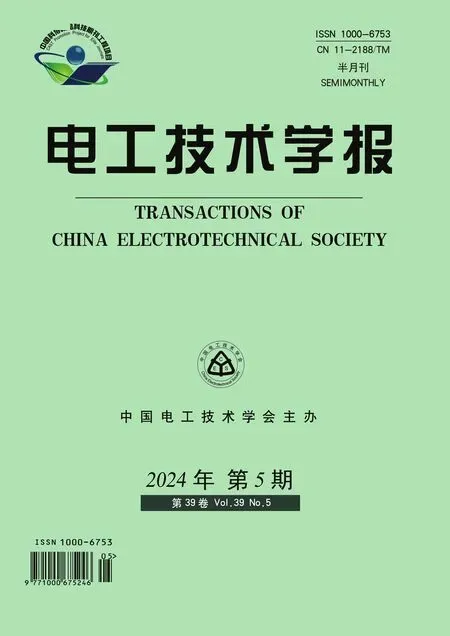基于片段充电数据和DEKF-WNN-WLSTM的锂电池健康状态实时估计
宋显华 姚全正
基于片段充电数据和DEKF-WNN-WLSTM的锂电池健康状态实时估计
宋显华 姚全正
(哈尔滨理工大学理学院 哈尔滨 150080)
实时准确地评估电动汽车锂电池健康状态(SOH)对电动汽车的稳定行驶至关重要。因此,该文提出一种基于锂电池日常片段充电数据和双扩展卡尔曼滤波-小波神经网络-小波长短时记忆神经网络(DEKF-WNN-WLSTM)的电池全充时间估计模型,进而提高了片段充电数据评估电池健康状态的准确度。首先,设计双扩展卡尔曼滤波预测-校正算法,分别用来估计片段充电数据对应的全充时间和校正扩展卡尔曼滤波的状态初值,以提高估计的准确性。然后,设计了小波神经网络-小波长短时神经网络来学习扩展卡尔曼滤波递推过程的观测值。最后,通过实验仿真,验证了所提算法在锂电池健康状态实时估算中的准确性和有效性。
电池健康状态 片段数据 双扩展卡尔曼滤波 小波神经网络 小波长短时记忆神经网络
0 引言
由于锂电池具有重量轻、寿命长、效率高、成本低等优点,是电动汽车的主要动力来源[1],因此对于电动汽车的锂电池进行性能评价具有重要意义。通常情况下,锂电池通过电池管理系统(Battery Management System, BMS)进行性能评价[2]。BMS的评价指标主要包括荷电状态(State of Charge, SOC)、剩余使用寿命(Remaining Useful Life, RUL)和健康状态(State of Health, SOH)[3-5]。一般来说,SOH描述电池长期的状态变化,因此获得准确的SOH估计值对于电池长期安全稳定的使用至关重要。
主要的SOH评估方法可以分为三类:直接测量法、基于经验的方法和数据驱动方法。典型的直接测量法是通过累积电流积分测量电池的SOH[6]。但在实际应用中,该方法对电流采样精度敏感,应用效果不佳。电化学阻抗谱(Electrochemical Impedance Spectroscopy, EIS)是另一种直接方法[7-8],通过分析电池在不同频率下的交流阻抗谱,得到电池内部的化学状态,进而评价电池的外部特征。然而电池内部参数的采集需要特殊且昂贵的设备,且参数分析过程复杂。基于经验的方法包括周期计数法、面向事件的累积法、安时法以及加权安时法等[9]。然而,在实际应用中,电池的工作条件往往与标准工作条件不一致,这将导致较大的估计误差。最后一个主流的方法是数据驱动方法,该方法通过学习隐藏于数据中的信息来估计SOH,不需要电池系统的先验知识。因此,数据驱动方法可以避免模型获取困难的问题,是一种更加实用的估计方法。
支持向量机(Support Vector Machine, SVM)是一种常用的数据驱动算法,它通过核函数将低纬度空间的非线性问题映射到高纬度空间[10]的线性问题来估计SOH,但该方法不易选择合适的核函数且对交叉训练和正则化方法依赖程度高。相关向量机(Relevance Vector Machine, RVM)的原理与支持向量机大致相同,不同的是其网络权值是用稀疏贝叶斯理论结构获得的[11]。然而,由于RVM模型的稀疏矩阵,RVM对训练数据的需求较高且预测结果的稳定性较差。高斯过程回归(Gaussian Process Regression, GPR)是另一种基于贝叶斯框架的估计方法[12-13],但该算法中超参数较多,训练中调整过程繁琐。基于神经网络的方法作为一种高效的数据驱动方法,正在成为电池性能评估的主流方法[14-18]。其中,小波神经网络(Wavelet Neural Network, WNN)结合自学习和非线性函数逼近能力,具有精度高和细节描述能力强的优点[19-20]。J. Zhang等提出了将离散小波多分辨率分解与多层感知器相结合的四层小波神经网络,与反向传播神经网络(Back Propagation Neural Networks, BPNN)相比具有较好的预测性能。但该方法局限于多分辨率分析,结构不灵活且鲁棒性不强[21]。Xia Bizhong等通过引入小波伸缩因子和小波平移因子,调整小波神经网络的结构,使网络具有较强的鲁棒性[22]。但由于它只是一个三层网络,其估计精度远远低于深度网络。与BPNN相比,循环神经网络(Recurrent Neural Network, RNN)可以保存输入数据与SOH值之间的信息,因此常被用于SOH估计[23]。但由于梯度消失和梯度爆炸的问题,RNN无法用于长期估计。为了解决这一问题,引入了长短时记忆神经网络(Long Short Term Memory, LSTM)[24-26]。LSTM具有单元状态,可以保存输入和输出之间的重要信息。然而,由于LSTM的单元特性,当测试数据与训练数据之间的相关性不高时,其估计效果不好,意味着该方法的鲁棒性不强。
因此,本文设计了一种小波神经网络和小波长短时记忆神经网络(Wavelet LSTM, WLSTM)。该网络包括输入层、两个隐藏层和输出层。双隐层由WNN层和WLSTM层组成,WLSTM层的激活函数用Morlet小波函数代替。因此,该网络同时具有WNN和LSTM的优点。
此外,为了能够更安全稳定地使用纯电力电动汽车,随时了解电池当前时刻的健康状态是十分有必要的,即实时估计电池的SOH。然而,锂电池是一个机制复杂、内部状态未测量的综合系统,SOH的在线估计通常依赖电池模型和关键参数之间的拟合关系。电池模型参数反映电池内部的动态响应,并会随着电池的退化而发生相应的变化。程泽等[27]在二阶RC网络等效电路模型的基础上,联合Sage-Husa自适应滤波思想,设计了自适应平方根无迹卡尔曼滤波(Adaptive Square Root Unscented Kalman Filter, ASRUKF)算法;通过对电池参数的实时更新,实现电池SOH的实时估计,虽然不涉及电化学分析过程,但是其电池特性变化的分析过程依旧较复杂。
王萍等[28]提出了一种基于数据驱动和经验模型结合的在线实时估计方法。其实时估计的核心为在固定循环次数下,利用观测器对模型的参数进行更新。该方法虽然实现了预测SOH的实时性,减少了监测器的负荷,但每次的参数更新需要离线操作,具有一定的不便性。
周頔等[29]用扩展卡尔曼滤波和高斯过程回归(Extended Kalman Filter and Gaussian Process Regression, EKF-GPR),不需要完成整个充放电操作,仅对日常片段充电数据进行处理,通过估计片段数据的全充时间,进而得到电池在当前时刻的SOH,实现了电池的实时估计,该方法的平均绝对误差在2%以下,短期内的评估值基本满足现实要求,解决了短时间内的动力电池锂电池健康状态的实时估计问题,具有一定的应用价值,但长期的预测精度不理想。
为了解决实时估计的精度问题,本文设计了双扩展卡尔曼滤波-小波神经网络-小波长短时记忆神经网络(DEKF-WNN-WLSTM)模型,用一次全充数据和三次片段数据分别训练两个WNN-WLSTM网络,然后将两个训练好的网络融入DEKF中,为EKF的循环递推提供相应的输出值。此外,构建双EKF实现电池全充时间的实时估计,其中第一个EKF用于估计片段数据对应的全充时间;第二个EKF用来估计当前循环下电池全充时间的估计值与真实值的误差,并实时修正当前循环次数下估计的全充时间,进而为下次循环中第一个EKF提供较准确的状态初值。实验结果表明,本文所提算法的平均绝对误差远远低于EKF-GPR,并且随着循环次数的增加,DEKF-WNN-WLSTM的累积误差也远远低于后者。
1 锂电池健康状态实时估计模型
1.1 基于充电容量的锂电池健康状态估算
一般情况下,SOH的定义为
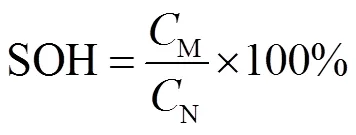
式中,M为测量放电容量;N为电池标称放电容量。该公式表示锂电池在标准条件下从充满状态以一定倍率放电到截止电压所放出的容量与其所对应的标称容量的比值[29]。


用充电数据估算SOH具有简便快捷的显著优势,并且由文献[29]可知:充电容量计算的SOH和放电容量计算的SOH具有一致性,因此,本文采用片段充电数据作为输入,估计电池的全充时间,进而估算电池的健康状态是合理的。
1.2 基于全充充电时间估算的电池健康状态
电池容量是指在某种条件下,活性物质参加电化学反应所释放电量的多少,有时也会将电池所能充入的最大电量作为电池容量。相同地,基于恒流充电的动力电池SOC计算公式为
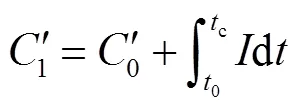

基于式(4),定义基于充电容量的SOH为

该方法可以简便地计算动力电池的SOC和SOH,缺点是电池需要从零容量充电至截止电压,该过程费时且不方便。
通常情况下,在充电效率一定时,电池从零容量开始充电至充满状态所用的时间越长,电池的容量也就越大。随着电池不断的循环充放电,其恒流充电时间在不断缩短[30],这与SOH整体下降的趋势一致。而在本文中,由式(5)可知,SOH和电池的充电时间成正比,二者具有较强的相关性,基于此,只要得到电池的全充时间,即可得到电池的SOH。
1.3 基于日常片段充电数据的SOH估算模型
由于电动汽车在实际的使用情况较复杂,其动力电池的充电情况往往是片段的,而非完全充电,例如,SOC从30%或50%充至80%或100%的充电情况,就无法根据充电情况判断出电池的实时全充时间和可用容量。本文基于该情况,同文献[29],构建利用从任意的起始SOC值处进行恒流充电至100%这样的片段数据,估计锂电池当前的全充时间,进而计算电池当前时刻的SOH。
2 双卡尔曼滤波-小波神经网络-小波长短时记忆神经网络算法
本节主要介绍基于DEKF-WNN-WLSTM算法并使用片段数据对电池的实时全充时间进行预测。
2.1 扩展卡尔曼滤波(EKF)
扩展卡尔曼滤波算法是由卡尔曼滤波转变而来,其核心在于对非线性系统的局部线性化。该算法的实质是基于递归估算的最优自适应算法。EKF是广泛使用的非线性系统的最优状态估计算法[31]。一般情况下,扩展卡尔曼滤波由状态方程和测量方程组成,算法方程为

2.2 小波神经网络(WNN)
小波神经网络以全连接网络和小波理论为基础,用小波分析理论构建并改进神经网路结构,与通常使用的全连接神经网络相比(如BPNN),其激活函数被一组小波函数代替,这些函数由Morlet小波母函数产生[22]。



图1 三层小波神经网络结构
Fig.1 Schematic structure of the WNN


2.3 长短时记忆神经网络(LSTM)
相比于循环神经网络(RNN)存在梯度消失和梯度爆炸等问题,长短时记忆神经网络在处理具有时间序列特性的数据时具有明显的优势,因为后者有一个可以保存重要的信息记忆状态。图2描述了长短时记忆神经网络的细胞结构,它用遗忘门、输入门、输出门和记忆单元训练网络。

图2 LSTM的细胞结构示意图
该过程可以用公式表示为





最后获得输出为

2.4 小波神经网络-小波长短时记忆神经网络(WNN-WLSTM)

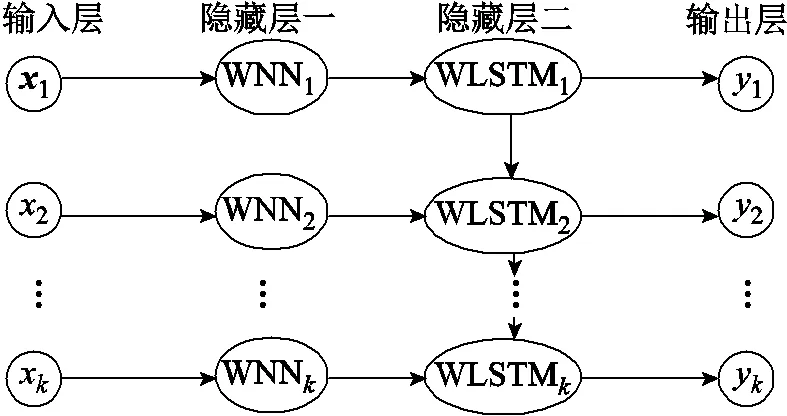
图3 WNN-WLSTM结构示意图
隐藏层二是小波长短时记忆层,该层的激活函数是Morlet小波函数,因此,修改后的LSTM层公式(11)~式(14)和式(16)为





在式(17)~式(21)中为Morlet小波函数。此外,因为式(16)中没有激活函数,所以WLSTM层依旧采用原公式。
调整后的WLSTM层依旧可以提取数据间的时间序列特征,实验表明WNN-WLSTM能够为扩展卡尔曼滤波提供较为准确的测量值。
损失函数用于量化模型预测值与实测值之间的差异,并根据差异更新网络的各项参数,本文所用的损失函数为
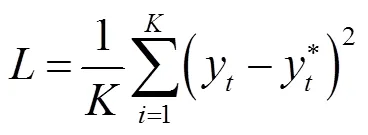
最小化损失函数是由优化器确定的,本文选择RMSprop优化器。
2.5 WNN-WLSTM学习过程



2.6 双扩展卡尔曼滤波-小波神经网络-小波长短时记忆网络(DEKF-WNN-WLSTM)算法
本文提出的算法将WNN-WLSTM融入扩展卡尔曼滤波中,采用两个WNN-WLSTM网络以及双卡尔曼滤波提高系统模型预测性能,模型的流程如图4所示,其中为循环的次数上限。

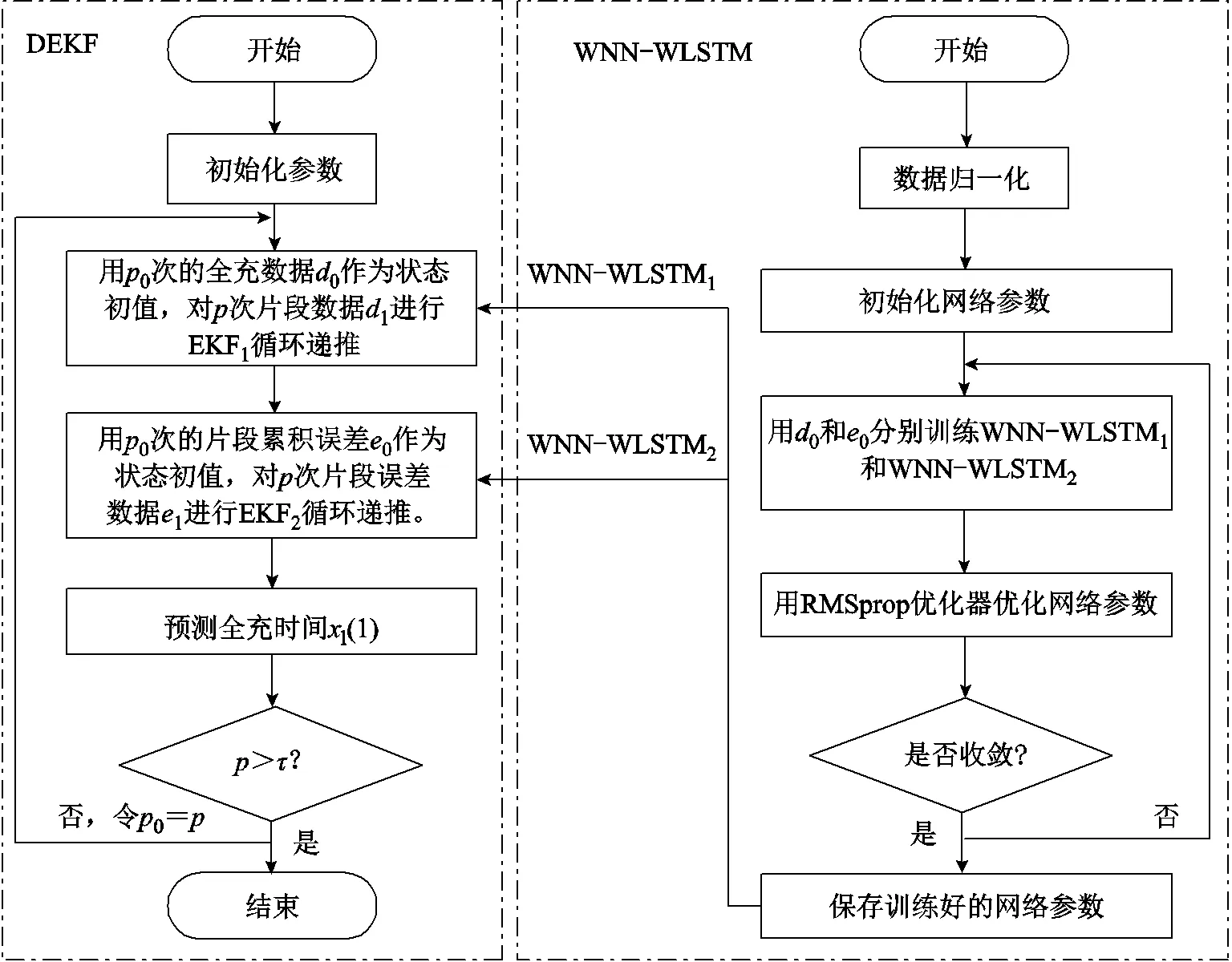
图4 DEKF-WNN-WLSTM流程
步骤(2)~(4)为训练阶段:该阶段训练两个WNN-WLSTM。


状态方程为

测量方程为



步骤(5)~(10)为测试阶段该阶段,融合WNN-WLSTM和DEKF,估计片段数据对应的全充时间
(6)扩展卡尔曼滤波一:循环递推
预测:

利用差商近似雅可比矩阵更新模型为

计算增益:
更新状态:

更新协方差:
状态方程:

测量方程:
(8)扩展卡尔曼滤波二:循环递推
预测:

利用差商近似雅可比矩阵进行更新模型:
计算增益

更新状态
更新协方差

(9)预测全充时间与真实的全充时间的误差

3 实验仿真及其分析
为了展示所提算法的有效性,本文选用深圳新威尔电子公司提供的三元锂电池充放电数据库进行实验,该电池首先在2 100 mA的恒流条件下充电,直到电池电压达到8.4 V;然后在恒流2 100 mA水平下放电,直到电池电压达到5.6 V,如图5和图6所示。实验首先验证了DEKF-WNN-WLSTM算法的有效性,然后和EKF-GPR算法做对比,验证本文算法准确性,最后用DEKF算法估计的全充时间评估电池的健康状态。
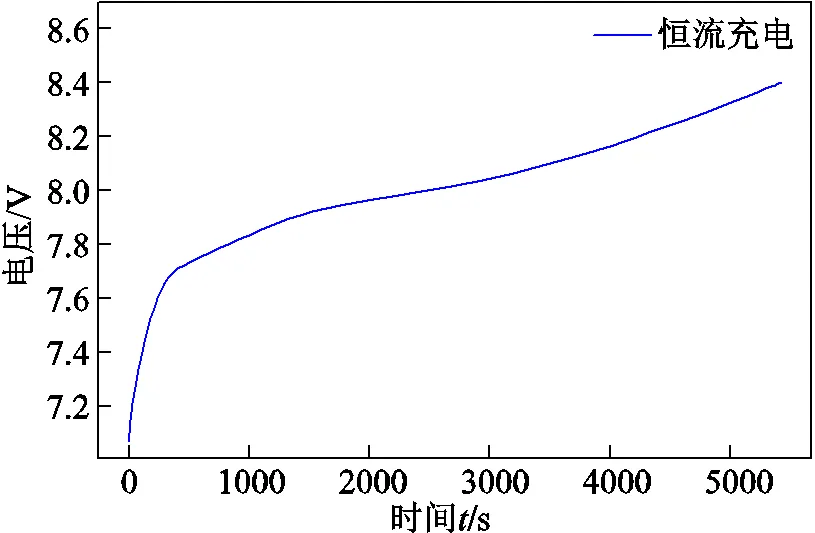
图5 恒流充电模式
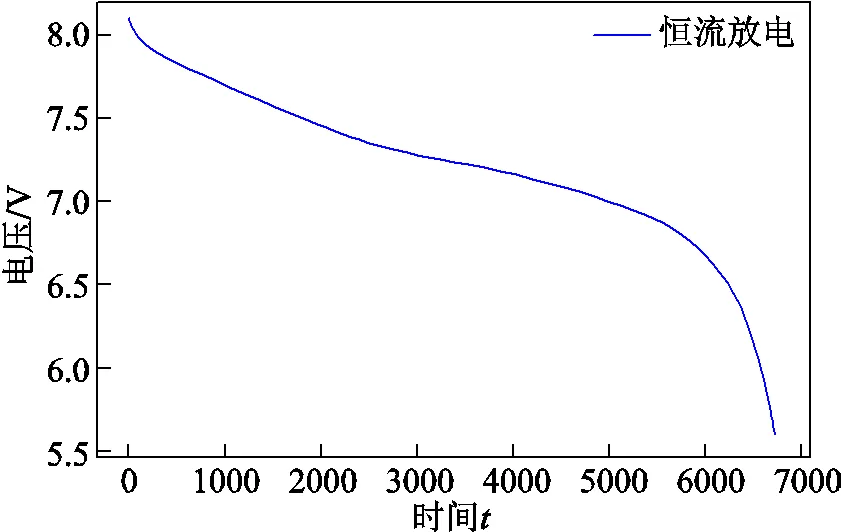
图6 恒流放电模式
3.1 仿真软件
实验硬件设施采用Inter(R) Core(TM) i5-7200u CPU @ 2.50 GHz处理器,Windows7旗舰版64位操作系统和8 GB运行内存。编程软件为Matlab 2018和Python 3.8,其中Python以深度学习框架Keras为支撑,实现了基于TensorFlow的WNN-WLSTM仿真模型的构建,为Matlab构建的双卡尔曼滤波模型提供相应的测量值。
3.2 DEKF-WNN-WLSTM预测全充时间
图7是估计的全充时间和真实的全充时间对比图,可以看到,除个别变化较快的周期外,二者变化情况基本完全一致。这说明本文提出的DEKF-WNN-WLSTM算法能够在较低的误差范围内利用日常片段充电数据估计电池的全充时间。
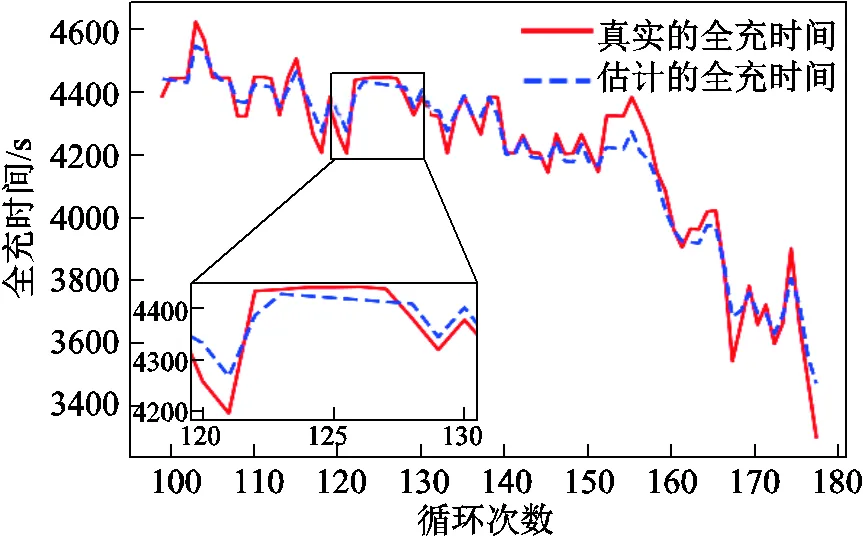
图7 估计的全充时间和真实的全充时间


图8 估计全充时间的绝对误差

图9 估计全充时间的相对误差

图10 估计全充时间的相对误差绝对值
3.3 与文献[29]算法的比较
为了进一步证明所提方法的预测性能,本节与周頔等[29]提出的基于EKF-GPR方法进行比较。图11为两种方法估计和真实的全充时间对比图。从图中可以看到:本文所提的算法相比于EKF-GPR更接近真实值,尤其是在循环次数为125~135和170~180时。这说明随着循环次数的增加,DEKF-WNN-WLSTM方法能够缓解一定的误差增长,在不人为进行一次全放全充操作以更新初始全充时间值的条件下,本文所提方法具有更好的估计效果。

图11 两种估计方法的结果比较
表1为两种方法的平均相对误差,DEKF-WNN-WLSTM的平均相对误差为0.010 1,低于EKF-GPR的0.017 6,进一步说明本文所提方法的准确性高。
表1 两种方法的平均相对误差

Tab.1 The average relative error of the two methods
图12~图14分别为两种估计方法的绝对误差、相对误差和相对误差绝对值。可以发现:DEKF-WNN-WLSTM相对于EKF-GPR而言,其误差曲线普遍低于后者,尤其是循环次数在165~180之间时,二者的误差曲线相差最远,这说明本文方法具有较好的预测能力。

图12 两种方法的绝对误差
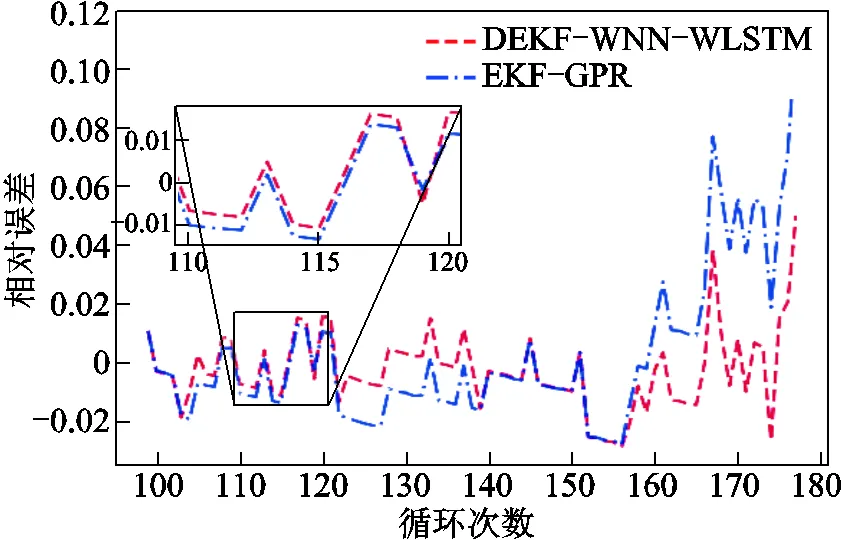
图13 两种方法的相对误差
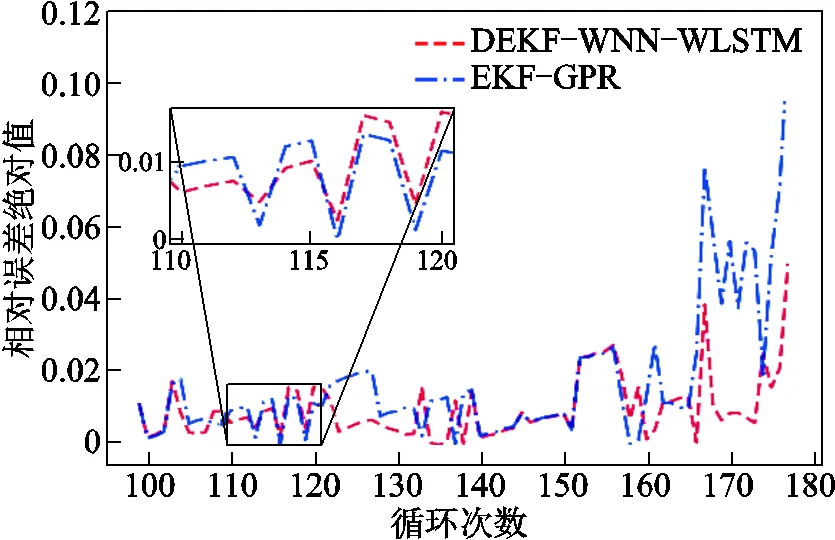
图14 两种方法的相对误差绝对值
3.4 实时SOH估计分析
本文采用式(3)所示的基于充电容量评估电池SOH的模型。由式(2)和式(3)可得电池的SOH为

式中,()为第次循环的全充时间。

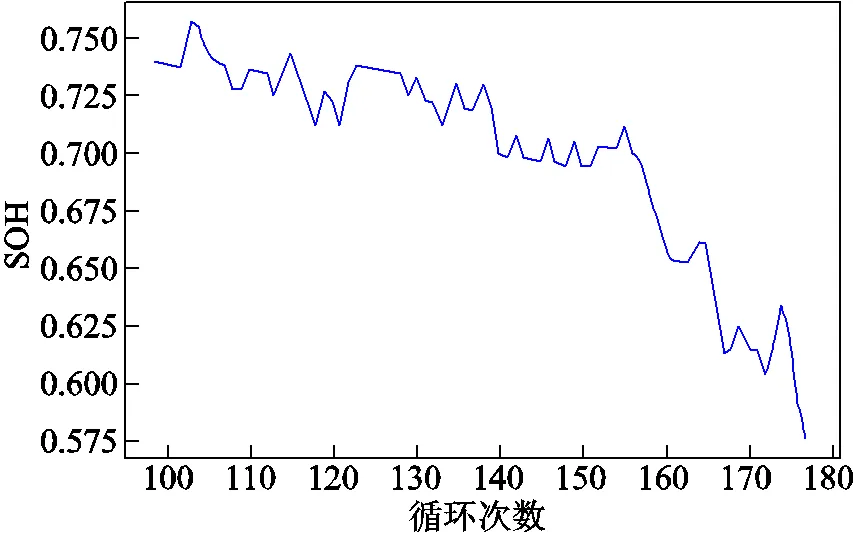
图15 本文方法估计的SOH
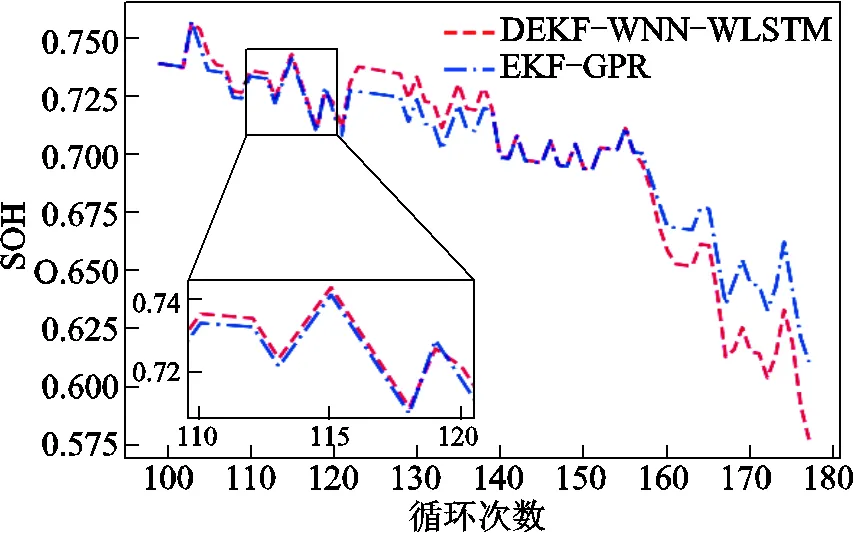
图16 两种方法估计的SOH
4 结论
本文提出了基于DEKF-WNN-WLSTM和日常片段充电数据的锂电池健康状态估计算法,其核心为利用小波神经网络-小波长短时记忆神经网络优秀的学习和预测性能,去学习扩展卡尔曼滤波的量测方程,在一定的噪声假设下,可以实现电池健康状态的实时预测,有利于电池的维护以及电动汽车在现实生活中的广泛使用。实验仿真结果表明,相比于EKF-GPR电池SOH实时估计模型,本文所提方法能够有效缓解误差的累积,且短期内的预测值和真实值的差异基本可以控制在1%左右。最后,利用充电容量估算SOH模型,实现了电池SOH的实时评估。
[1] Al-Ghussain L, Darwish Ahmad A, Abubaker A M, et al. An integrated photovoltaic/wind/biomass and hybrid energy storage systems towards 100% renewable energy microgrids in university campuses[J]. Sustainable Energy Technologies and Assessments, 2021, 46: 101273.
[2] Guo Yuanjun, Yang Zhile, Liu Kailong, et al. A compact and optimized neural network approach for battery state-of-charge estimation of energy storage system[J]. Energy, 2021, 219: 119529.
[3] Zhang Zhengxin, Si Xiaosheng, Hu Changhua, et al. Degradation data analysis and remaining useful life estimation: a review on Wiener-process-based methods[J]. European Journal of Operational Research, 2018, 271(3): 775-796.
[4] Hu Xiaosong, Feng Fei, Liu Kailong, et al. State estimation for advanced battery management: key challenges and future trends[J]. Renewable and Sustainable Energy Reviews, 2019, 114: 109334.
[5] Shrivastava P, Soon T K, Bin Idris M Y I, et al. Overview of model-based online state-of-charge estimation using Kalman filter family for lithium-ion batteries[J]. Renewable and Sustainable Energy Reviews, 2019, 113: 109233.
[6] Chen Zheng, Xue Qiao, Xiao Renxin, et al. State of health estimation for lithium-ion batteries based on fusion of autoregressive moving average model and Elman neural network[J]. IEEE Access, 2019, 7: 102662-102678.
[7] Lyu Chao, Zhang Tao, Luo Weilin, et al. SOH estimation of lithium-ion batteries based on fast time domain impedance spectroscopy[C]//2019 14th IEEE Conference on Industrial Electronics and Applications (ICIEA), Xi'an, China, 2019: 2142-2147.
[8] Kwiecien M, Badeda J, Huck M, et al. Determination of SoH of lead-acid batteries by electrochemical impedance spectroscopy[J]. Applied Sciences, 2018, 8(6): 873.
[9] Sauer D U, Wenzl H. Comparison of different approaches for lifetime prediction of electrochemical systems—using lead-acid batteries as example[J]. Journal of Power Sources, 2008, 176(2): 534-546.
[10] Zhang Ji’ang, Wang Ping, Gong Qingrui, et al. SOH estimation of lithium-ion batteries based on least squares support vector machine error compensation model[J]. Journal of Power Electronics, 2021, 21(11): 1712-1723.
[11] Wang Shuai, Zhang Xiaochen, Chen Wengxiang, et al. State of health prediction based on multi-kernel relevance vector machine and whale optimization algorithm for lithium-ion battery[J]. Transactions of the Institute of Measurement and Control, 2021, DOI: 101177/01423312211042009.
[12] 杨胜杰, 罗冰洋, 王菁, 等. 基于容量增量曲线峰值区间特征参数的锂离子电池健康状态估算[J]. 电工技术学报, 2021, 36(11): 2277-2287. Yang Shengjie, Luo Bingyang, Wang Jing, et al. State of health estimation for lithium-ion batteries based on peak region feature parameters of incremental capacity curve[J]. Transactions of China Electrotechnical Society, 2021, 36(11): 2277-2287.
[13] 韩乔妮, 姜帆, 程泽. 变温度下IHF-IGPR框架的锂离子电池健康状态预测方法[J]. 电工技术学报, 2021, 36(17): 3705-3720. Han Qiaoni, Jiang Fan, Cheng Ze. State of health estimation for lithium-ion batteries based on the framework of IHF-IGPR under variable temperature[J]. Transactions of China Electrotechnical Society, 2021, 36(17): 3705-3720.
[14] 李超然, 肖飞, 樊亚翔, 等. 基于卷积神经网络的锂离子电池SOH估算[J]. 电工技术学报, 2020, 35(19): 4106-4119. Li Chaoran, Xiao Fei, Fan Yaxiang, et al. An approach to lithium-ion battery SOH estimation based on convolutional neural network[J]. Transactions of China Electrotechnical Society, 2020, 35(19): 4106-4119.
[15] 郭永芳, 黄凯, 李志刚. 基于短时搁置端电压压降的快速锂离子电池健康状态预测[J]. 电工技术学报, 2019, 34(19): 3968-3978. Guo Yongfang, Huang Kai, Li Zhigang. Fast state of health prediction of lithium-ion battery based on terminal voltage drop during rest for short time[J]. Transactions of China Electrotechnical Society, 2019, 34(19): 3968-3978.
[16] Fan Yaxiang, Xiao Fei, Li Chaoran, et al. A novel deep learning framework for state of health estimation of lithium-ion battery[J]. Journal of Energy Storage, 2020, 32: 101741.
[17] Bonfitto A. A method for the combined estimation of battery state of charge and state of health based on artificial neural networks[J]. Energies, 2020, 13(10): 2548.
[18] Zhang Sihan, Hosen M S, Kalogiannis T, et al. State of health estimation of lithium-ion batteries based on electrochemical impedance spectroscopy and backpropagation neural network[J]. World Electric Vehicle Journal, 2021, 12(3): 156.
[19] Chang Chun, Wang Qiyue, Jiang Jiuchun, et al. Lithium-ion battery state of health estimation using the incremental capacity and wavelet neural networks with genetic algorithm[J]. Journal of Energy Storage, 2021, 38: 102570.
[20] Jia Jianfang, Wang Keke, Pang Xiaoqiong, et al. Multi-scale prediction of RUL and SOH for lithium-ion batteries based on WNN-UPF combined model[J]. Chinese Journal of Electronics, 2021, 30(1): 26-35.
[21] Zhang J, Gao X P, Li Y Q. Efficient wavelet networks for function learning based on adaptive wavelet neuron selection[J]. IET Signal Processing, 2012, 6(2): 79.
[22] Xia Bizhong, Cui Deyu, Sun Zhen, et al. State of charge estimation of lithium-ion batteries using optimized Levenberg-Marquardt wavelet neural network[J]. Energy, 2018, 153: 694-705.
[23] Chang Wen-Yeau, Chang Po-Chuan. Application of radial basis function neural network, to estimate the state of health for LFP battery[J]. International Journal of Electrical and Electronics Engineering (IJEEE), 2018, 7(1): 1-6.
[24] 周才杰, 汪玉洁, 李凯铨, 等. 基于灰色关联度分析-长短期记忆神经网络的锂离子电池健康状态估计[J]. 电工技术学报, 2022, 37(23): 6065-6073. Zhou Caijie, Wang Yujie, Li Kaiquan, et al. State of health estimation for lithium-Ion battery based ongray correlation analysis and long short-term memory neural network[J]. Transactions of China Electrotechnical Society, 2022, 37(23): 6065-6073.
[25] 黄凯, 丁恒, 郭永芳, 等. 基于数据预处理和长短期记忆神经网络的锂离子电池寿命预测[J]. 电工技术学报, 2022, 37(15): 3753-3766. Huang Kai, Ding Heng, Guo Yongfang, et al. Prediction of remaining useful life of lithium-ion battery based on adaptive data preprocessing and long short-term memory network [J]. Transactions of China Electrotechnical Society, 2022, 37(15): 3753-3766.
[26] Kim S J, Kim S H, Lee H M, et al. State of health estimation of Li-ion batteries using multi-input LSTM with optimal sequence length[C]//2020 IEEE 29th International Symposium on Industrial Electronics (ISIE), Delft, Netherlands, 2020: 1336-1341.
[27] 程泽, 杨磊, 孙幸勉. 基于自适应平方根无迹卡尔曼滤波算法的锂离子电池SOC和SOH估计[J]. 中国电机工程学报, 2018, 38(8): 2384-2393. Cheng Ze, Yang Lei, Sun Xingmian. Estimation of SOC and SOH of Li-ion battery based on adaptive square root unscented Kalman filter algorithm[J]. Proceedings of the CSEE, 2018, 38(8): 2384-2393.
[28] 王萍, 弓清瑞, 张吉昂, 等. 一种基于数据驱动与经验模型组合的锂电池在线健康状态预测方法[J]. 电工技术学报, 2021, 36(24): 5201-5212. Wang Ping, Gong Qingrui, Zhang Jiang, et al. An online state of health prediction method for lithium batteries based on combination of data-driven and empirical model[J]. Transactions of China Electrotechnical Society, 2021, 36(24): 5201-5212.
[29] 周頔, 宋显华, 卢文斌, 等. 基于日常片段充电数据的锂电池健康状态实时评估方法研究[J]. 中国电机工程学报, 2019, 39(1): 105-111. Zhou Di, Song Xianhua, Lu Wenbin, et al. Real-time SOH estimation algorithm for lithium-ion batteries based on daily segment charging data[J]. Proceedings of the CSEE, 2019, 39(1): 105-111.
[30] Yang Duo, Zhang Xu, Pan Rui, et al. A novel Gaussian process regression model for state-of-health estimation of lithium-ion battery using charging curve[J]. Journal of Power Sources, 2018, 384: 387-395.
[31] Julier S J, Uhlmann J K. New extension of the Kalman filter to nonlinear systems[C]//AeroSense '97. Proc SPIE 3068, Signal Processing, Sensor Fusion, and Target Recognition VI, Orlando, FL, USA, 1997, 3068: 182-193.
Real-Time State of Health Estimation for Lithium-Ion Batteries Based on Daily Segment Charging Data and Dual Extended Kalman Filters-Wavelet Neural Network-Wavelet Long Short-Term Memory Neural Network
Song Xianhua Yao Quanzheng
(School of Science Harbin University of Science and Technology Harbin 150080 China)
As a clean technology to solve carbon emissions, electric vehicles have been widely used in modern vehicles. Due to its high energy density, light weight, long life and low self discharge, lithium-ion batteries have become the main energy storage equipment of electric vehicles. Real time and accurate evaluation of the state of health (SOH) of the lithium batteries is critical to the stable driving of electric vehicles. However, most traditional SOH forecast methods are offline, which makes it difficult to obtain the SOH of the batteries in real time. Recently, some methods were presented to forecast the SOH of lithium-ion batteries, but most of them suffered from inconvenient adjustment of battery model parameters and accumulation of errors. To address these issues, this paper proposes a battery full charging time estimation model and dual extended Kalman filters-wavelet neural network-wavelet long short-term memory neural network (DEKF-WNN-WLSTM). By taking the daily segment charging data of lithium batteries as input, to predict the full time charging of the battery, and then get the SOH in real time.
Firstly, based on the strong robustness of wavelet neural network (WNN) and the ability of long short term memory (LSTM) to extract the time series features of the data, the neural network of WNN-WLSTM is designed. Secondly, two WNN-WLSTM networks are trained with one full charging data and three fragment data of lithium batteries, respectively. Thirdly, a real-time estimation algorithm named DEKF is constructed, in which the first EKF is used to estimate the full charging time corresponding to the segment data, and the second EKF is used to predict the error between the estimated and measured battery full charging time under the current cycle. Then the two trained networks are integrated into DEKF to provide corresponding output values for the cyclic recursion of EKF. Finally, a real-time SOH estimation model based on daily segment charging data is designed. The segment data from constant current charging to full charging at any time is used as the input of DEKF-WNN-WLSTM, to estimate the current full charging time of lithium batteries, then calculate the SOH of the battery at the current time. In this real-time model, the WNN-WLSTM alleviates the inconvenient adjustment of battery model parameters problem, addresses the long-term dependence problem. The DEKF uses the daily segment charging data as the input, which extends the practical application of the model.
Simulation results on the actual battery charging and discharging data show that, the mean relative error of the predictions for the entire 80 cycles is 0.010 1, the estimated error for the first 50 cycles is completely less than 2%, and less than 1% at most times. The comparison between DEKF-WNN-WLSTM and extended Kalman filter and Gaussian process regression (EKF-GPR) shows that, the mean relative error of EKF-GPR is 0.017 6, which is higher than DEKF-WNN-WLSTM, especially in the 170~180 cycles, which indicates that the model of DEKF-WNN-WLSTM can alleviate certain error growth with the increase of cycles. The proposed method has a better estimation effect under the condition that no artificial full recharge operation is performed to update the initial full charging time value.
The following conclusions can be drawn from the simulation analysis: (1)The proposed method integrates WNN-WLSTM neural network, which address the problems of long-term dependence and the inconvenient adjustment of battery model parameters. (2) Compared with EKF-GPR, the DEKF-WNN-WLSTM not only improves the prediction accuracy, but also alleviates the error accumulation. (3) The proposed model only needs the daily segment charging data. In this sense, it is practical in the real world.
State of health, segment data, dual extended Kalman filter, wavelet neural network, wavelet long short-term memory
10.19595/j.cnki.1000-6753.tces.222241
TM911
黑龙江省自然科学基金联合引导项目(LH2022F032)和山东省自然科学基金联合基金培育项目(ZR2022LLZ003)资助。
2022-12-28
2023-02-14
宋显华 女,1981年生,博士,副教授,博士生导师,研究方向为机器学习和智能状态监测、图像安全和量子计算等。E-mail:songxianhua@hrbust.edu.cn(通信作者)
姚全正 男,1997年生,硕士研究生,研究方向为机器学习以及电动汽车动力电池健康状态评估。E-mail:2311884748@qq.com
(编辑 郭丽军)

